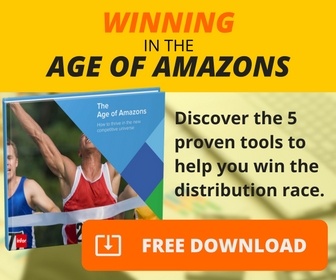In my last article I asked the question, "Are you still distributing like it's 1999" I also compared old-school, paper-based sales, ordering, and fulfillment processes with the methods of a 21st-century distribution business-"Distributor 2.0"-that's maximizing today's avaliable technology.
Distributor 2.0 isn’t hypothetical. These are real, thriving companies, some of whom we work with. In my opinion they’re visionary distribution businesses. They know where they want to go and how they want to grow. And they’re committed to doing what it takes to get there. It starts with growing their sales, and the #1 thing they’re doing in that effort is establishing eCommerce sales channels.
Old-fashioned methods won't grow your distribution business.
For Distributor 2.0, the old “inside sales/outside sales” model isn’t in the rearview mirror, but it has taken a back seat.
- It’s inefficient. Cold-calling and traveling are time-consuming efforts with hit-or-miss returns.
- It's slow. Manual paper-based processes are a tremendous drag on order fulfillment speed when customers "want it yesterday."
- It's error-prone. With every manual process someone might make a mistake, and mistakes come with costs.
- It isn't scalable. Your salespeople ARE valuable for maintaining major customer relationships, but they can only sell so much every month.
- It's geographically limited. Your outside salespeople can cover only so much ground. Added territories mean added costs.
- It's a big cost center. Just look at your budget for salaries, commissions, incentives, benefits, expenses, etc.
It’s no longer enough to be a middleman between manufacturers and retailers. If you want to grow your distribution business, you need to become a hybrid company that does more to push its inventory into the marketplace. eCommerce is a key component of that transformation.
With eCommerce, you meet your customers where and when they're shopping and purchasing.
According to the latest available Pew Research data, close to 80% of Americans shop online. If you’re in that consumer cohort (I most certainly am), then you value the speed, convenience, and ease of eCommerce. Not to mention the fact that you can find pretty much any item for sale online.
It shouldn’t be surprising, then, that commercial purchasers feel the same way. Forrester projects US B2B eCommerce to grow by 7.4% annually through 2021, reaching $1.2 trillion in that timeframe.
Done right, eCommerce can grow your sales exponentially.
Think about it: You’re open for business 24/7, capable of taking orders from as many customers as visit your site. You’re no longer limited to how many miles your outside sales team can log or how many phone calls your inside sales team can make. And your customers never have to wait on hold. In the current vernacular, it’s called “frictionless selling.” Successful eCommerce companies strive to make it as easy as possible for their customers to buy.
The opportunity is clear. How do you seize it?
eCommerce choices for distributors
You have two options for eCommerce deployment: through your own website, or through third-party platforms
Using your own website as an eCommerce store.
By building your own eCommerce store you can directly and seamlessly connect your website visitors to an identically branded purchase experience. When that experience is easy, quick, and complete, you’ll grow sales, earn repeat customers, and strengthen your brand identity.
Selling through 3rd-party channels.
Building your own online store might feel like a giant leap for your business. The good news is, you can establish a highly effective eCommerce presence on Amazon, eBay, and other 3rd-party sites through platforms like Channel Advisor, SellerCloud, Brightpearl, SellerActive, and others.
No matter how you "set up shop," your eCommerce store should do ALL these things:
- Have full mobile capabilities. I can't overemphasize, for two reasons:
- In 2017, mobile as percentage of all web traffic exceeded 50% for the first time. That percentage will only increase.
- Google has recently begun to rank websites primarily based on their mobile versions.
- Leverage the inventory and customer data that’s already living in your ERP.
- Accommodate your complete product line-with all its minute variations-now and in the future.
- Make your complete inventory easy for customers to search.
- Recommend other, relevant products.
- Allow your customers to build shopping lists.
- Integrate seamlessly with your warehouse management and shipping systems.
- Auto-send emails confirming orders, notifying that items have shipped, following up to ask for reviews, etc.
If you build it, will they come?
You'll need to attract traffic to your new online store when you launch it and on an ongoing basis. There's a broad range of tactics to choose from:
- Email marketing. Numerous low-costs platforms simplify the creation, management, and analysis of email campaigns.
- Social media. You can cover a lot of ground at no cost on just Facebook, Twitter, and, if it's appropriate for your business, Instagram.
- SEO. Through search engine optimization, you leverage keywords and other web page attributes to try and lift your search rankings over time.
- Paid Search and paid social. These are advertising strategies for search engines and social media. They require fairly constant testing and monitoring to optimize your results over time.
- Blogging. Regular blog posts announcing or reviewing products or answering FAQs - supported by email and social promotion - can draw attention to your store.
- Soliciting product reviews. The more positive reviews your online store has, the better its reputation will be. Reviews are also an opportunity to resolve issues and solidify your reputation for customer service.
Be channel conflict-averse.
As a hybrid distributor, it’s critical that you avoid channel conflict (a.k.a. disintermediation). In other words, you don’t want to undercut your loyal retail customers as you cast a wider, direct-to-consumer sales net.
There are numerous strategies for avoiding channel conflict. The most common ones focus on pricing. You can set fixed (and competitive) pricing for inventory in your online store, while allowing your sales team pricing flexibility that strikes a balance between your need to retain customers and your need to preserve your margins. (With the right software solution, you can pre-set minimum allowable pricing.)
Another way to avoid channel conflicts is to launch your online store under a different brand from your core business. By doing this, you mitigate two risks
- The risk of confusing your valued existing customer
- The larger risk of offending them with online store pricing that may undercut your already-agreed-upon pricing arrangements
Take it to the next level.
If you read my "1999" article, you saw that Distributor 2.0 processes every sale at high velocity, automating credit and inventory checks, picking, packing, and shipping. With eCommerce, ERP, and warehouse management systems fully integrated, there’s minimal opportunity for human error—AND same-day shipping is enabled on nearly all in-stock orders.
In conclusion
Yes, setting up and maintaining an eCommerce presence requires a commitment of time, human resources, and budget. But consider all the advantages:
- You make your inventory available worldwide.
- You can take orders 24/7, not just when your salespeople are on the clock.
- You can automatically recommend products to customers.
- Your cost per sale decreases beacuse you can make more sales with reduced headcount.
- And with CRM-powered eMarketing capabilities you can broadly and easily promote new products, discounts, speacial purchases, and other offers.
 If you’re committed to keeping your distribution enterprise competitive and viable, then consider—seriously consider—making eCommerce a core business initiative in 2018.
If you’re committed to keeping your distribution enterprise competitive and viable, then consider—seriously consider—making eCommerce a core business initiative in 2018.






